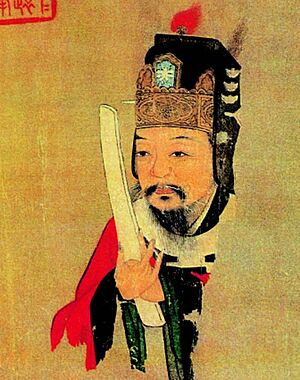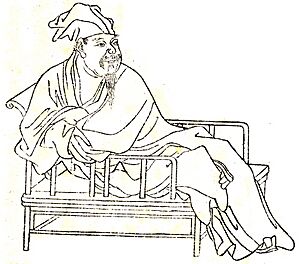Qingli Reforms facts for kids
| Simplified Chinese | 庆历新政 |
|---|---|
| Traditional Chinese | 慶曆新政 |
| Result | Failure |
| Other names | Minor Reforms Qingli New Deal Qingli New Policies |
The Qingli Reforms (also called the Qingli New Deal or Minor Reforms) were a series of changes in China during the Song dynasty. These reforms happened between 1043 and 1045. They were named after the "Qingli" era, which lasted from 1041 to 1048.
Two important leaders of these reforms were Fan Zhongyan and Ouyang Xiu. They tried to update how the government worked in China. The Qingli Reforms were the first big political changes during the Northern Song Dynasty. They lasted for about one year and four months but did not succeed. After the reforms failed, Fan Zhongyan was sent to live in a different region.
Contents
Who Was Fan Zhongyan?
Fan Zhongyan was a very important official in the city of Kaifeng in the 1030s. Kaifeng was the capital city of the Song dynasty. He was later moved to less important jobs because he spoke out against a powerful government leader.
In 1040, two groups from the north, the Liao and Western Xia, started to threaten China. Because of this, Fan Zhongyan was called back to the capital. His job was to help make China's defenses stronger.
Who Was Ouyang Xiu?
Ouyang Xiu became an official in Kaifeng in 1034. This was four years after he passed a very difficult government exam called the jinshi exam. He started working with Fan Zhongyan around this time.
Like Fan, Ouyang Xiu also faced problems for speaking his mind. After Fan Zhongyan was moved, Ouyang Xiu criticized the person who had caused Fan's problems. Because of this, Ouyang Xiu was sent to a small job in Hubei. He was also called back to the capital in the 1040s. There, he helped organize and list all the books in the emperor's huge library.
What Were the Ten Points?
Fan Zhongyan wrote a special report called the "Ten-Point Memorial." In this report, he explained his main goals for the reforms. These goals can be put into three main groups:
- Make the government work better and more efficiently.
- Make local governments stronger across the country.
- Improve China's defenses to protect against threats.
How Were the Reforms Put into Action?
The reforms started with several new rules. One rule allowed good officials to stay in their jobs for more than three years. It also made it easier to remove officials who were not good at their jobs or who were dishonest.
Another change was that sons and relatives of officials could no longer automatically get their father's job. The government also changed the imperial examinations. These were tests to become an official. Poetry became less important, and essays and Confucian classics became more important.
The government also kept a closer eye on officials in the provinces. These officials were in charge of moving tax grains. Now, the central government directly appointed them. Land given to officials was also shared out more fairly.
To help farmers, new walls and canals were built to improve how water was used for crops. Soldiers near the capital city were told to help with farming and get better training. The amount of forced labor that people had to do for the government was also reduced.
Finally, the government wanted its new rules and orders to be followed quickly. They also wanted to make sure these rules were actually put into practice.
Many of these changes were tried out between 1043 and 1045. However, the emperor did not fully support them. This meant the reforms were never completely put into action. Soon after they began, powerful groups, like rich landowners and other wealthy people, pushed back against the changes. Because of this, Fan Zhongyan and another official named Fu Bi were removed from their jobs in 1045.
One important part of the reforms that did last was the creation of the Imperial University. This school was made to educate the children of ordinary people and lower-ranking officials. It was the only part of the reforms that continued after the others were stopped.
What Happened Next?
About 30 years later, in the 1070s, another leader named Wang Anshi tried to bring back many of the Qingli Reforms. He even went further with his own changes. His reforms lasted longer than the Qingli Reforms. However, most of them also ended up failing, except for some changes to the examination system.
See also



